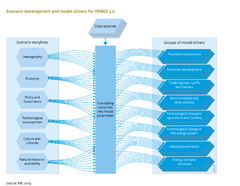Drivers/Scenario drivers: Difference between revisions
< Drivers
Jump to navigation
Jump to search
m (Text replace - "|Status=On hold" to "") |
No edit summary |
||
| Line 1: | Line 1: | ||
{{DriverPartTemplate | {{DriverPartTemplate | ||
|PageLabel=Scenario drivers | |PageLabel=Scenario drivers | ||
|Sequence=2 | |Sequence=2 | ||
| Line 6: | Line 5: | ||
|Description={{DisplayFigureTemplate|Flowchart D}} | |Description={{DisplayFigureTemplate|Flowchart D}} | ||
<h2>Scenario drivers</h2> | <h2>Scenario drivers</h2> | ||
When considering how the world might unfold in the longer term, six key scenario drivers are distinguished: demographics, economics, culture and lifestyle, natural resources, technological development and the policy and governance environment. To a large degree these scenario drivers are interdependent, and their future direction is often inferred from a simple to very elaborate ‘storyline’ or narrative. Such storylines describe the type and function of the scenario at hand: a reference projection with no new policies, a single ‘best-guess’ projection combining trends from the past with assumptions about how they might unfold in the future, multiple contrasting scenarios that span a range of uncertainty about the future, or a specific or broad policy scenario aiming to improve future outcomes. For examples, see ([[PBL, 2010]]; [[OECD, 2008]]; [[OECD, 2012]]; [[UNEP, 2011]]; [[PBL, 2011]]) | When considering how the world might unfold in the longer term, six key scenario drivers are distinguished: | ||
* demographics, | |||
* economics, | |||
* culture and lifestyle, | |||
* natural resources, | |||
* technological development and the | |||
* policy and governance environment. | |||
To a large degree these scenario drivers are interdependent, and their future direction is often inferred from a simple to very elaborate ‘storyline’ or narrative. Such storylines describe the type and function of the scenario at hand: a reference projection with no new policies, a single ‘best-guess’ projection combining trends from the past with assumptions about how they might unfold in the future, multiple contrasting scenarios that span a range of uncertainty about the future, or a specific or broad policy scenario aiming to improve future outcomes. For examples, see ([[PBL, 2010]]; [[OECD, 2008]]; [[OECD, 2012]]; [[UNEP, 2011]]; [[PBL, 2011]]) | |||
==Demographics== | ==Demographics== | ||
Revision as of 14:42, 24 January 2014
Parts of Drivers/Scenario drivers
| Projects/Applications |
| Models/Databases |
| Relevant overviews |
| Key publications |
| References |
